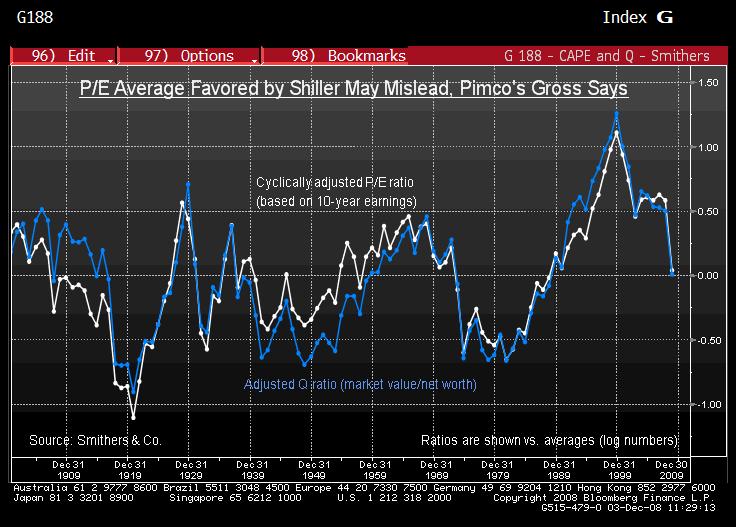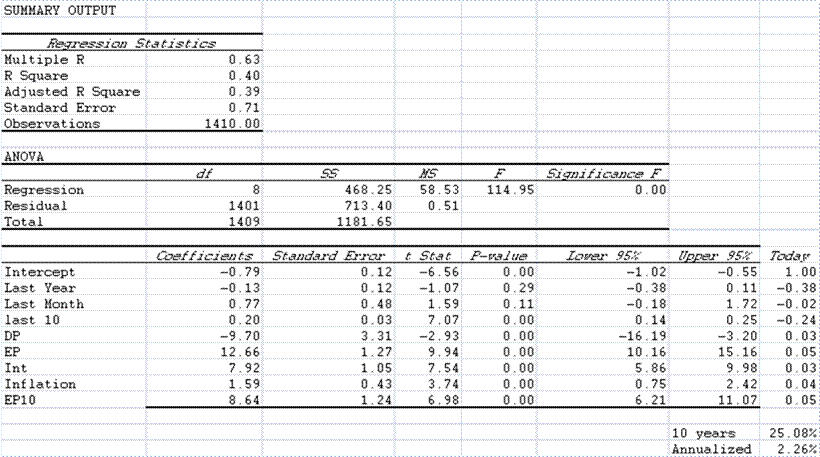One of the great conceits in investments is trying to earn above average returns with low variability of returns.? Yet, when you consider the Madoff scandal, it is what can attract a lot of money from credulous investors.
One of the glories of a capitalistic economy is that markets are unstable, they adjust to point out what is no longer needed.? Often the adustments occur violently, because businessmen/consumers chase trends, which can lead to bubbles and bubblettes, until the cash flows of the assets cannot bear the interest flows on the debts that have been created to buy the assets.? Attempts to tame this, such as Alan Greenspan’s aggressive provisions of liquidity just build up more debt for an economywide bubble, followed by a depression.? We got the Great Moderation because of trust in the Greenspan Put.? The Fed would only take away the punchbowl for modest amounts of time, so speculation on debt instruments, real estate, financial institutions, etc., could go on to a much greater degree.? Boom phases would be long; bust phases short and low-impact.
There have been problems with lax regulation of bank underwriting, and investment bank leverage, but the key flaw was mismanagement of the money/credit supply.? Had the Fed held credit tighter during the ’90s and 2000s, we would not be here now.? The Fed could have kept the fed funds rate high, rewarding savings, perhaps leading to a lower cuurent account deficit as well.? Debt growth would have slowed, and securitization, which hates having an inverted or flat yield curve, would have slowed as well.? GDP growth would have been slower, but we would not be facing the crisis we have now.
Or consider housing, and how it became overbuilt because of lax loan underwriting, accommodative monetary policy, and a follow-the-leader mania.? Here’s an old CC post from the era:

 |
 |
David Merkel |
| Pensions, Energy and Housing |
8/18/2005 3:32 PM EDT
 |
1) For those with stable businesses that throw off a lot of earnings and cash flow, and want to dodge the tax man, here’s a possible way to do it, courtesy of the Wall Street Journal: start a defined benefit plan. Disadvantages: complex, relatively illiquid and expensive. Advantages: you can sock away a lot, and defer taxes until you begin taking your benefit, possibly (maybe likely) at lower tax rates.
(This message brought to you courtesy of one actuary who won’t benefit from the message itself… but hey, it helps the profession.)
2) Sea changes in the markets rarely take place in a single day or week. Tops, and changes in leadership tend to take place over months, and feel uncertain. Though Jim is pretty certain that it is time to shift out of energy, I am willing to hang on, and get my opportunities to average down if they come at all. My rebalance points are roughly 20% below current prices anyway, so I’d need a real pullback in order to add.
Though there may be temporary inventory gluts, the basic supply/demand story hasn’t changed, and energy stocks still discount oil prices in the 40s, not the 60s.
3) Contrary to what Jim Cramer wrote in his housing piece today, you can lose it all in housing. Granted, it would be unusual to see homeowners in multiple areas in the country lose their shirts all at the same time; that hasn’t happened since the Great Depression, and we all know that the Great Depression can’t recur, right?
Thing is, local hot real estate markets often revert; if the reversion is bad enough, it leads to foreclosures. Think of Houston in the mid-80s, and Southern California in the early 90s. For that matter, think of CBD real estate in the early 90s… not only did that threaten real estate owners, it did in a number of formerly venerable banks and insurance companies.
Real estate is not a one way street, any more than stocks are. We have never financed as much real estate with as little equity as today before. We have not used financing instruments that are as back-end loaded before. Finally, this speculation is being done on a basis where renting is far cheaper than owning, leaving little support for property prices if the incomes of leveraged homeowners can’t be maintained in a recession. (Oh, that’s right. No more recessions; the Fed has cured that.)
Look, I’m not pointing at any immediate demise of housing in the hot markets. I still think that any trouble is a 2006-7 issue. But this is not a stable situation; if you have a large mortgage relative to your income, make sure your employment situation is really stable. If you can make the payment, prices on the secondary market don’t matter. If you can’t… those prices matter a lot.
One more note: an average investor can sell all of his stocks in the next 20 minutes, with little effect on the market. This is true even in a bad market. In a bad real estate market, you can’t sell; buyers are gunshy — it is akin to what I went through as a corporate bond manager in 2002. There are months where there is no liquidity for some bonds at any reasonable price. So it is for houses in some neighborhoods when half a dozen “for sale” signs go up. No one can sell except at fire sale prices.
None
Well, that’s the macroeconomic problem with stability.? When it gets relied on, after a self-reinforcing boom, it goes away.? Trust in stability is dangerous in other contexts, though.? From another CC post:

 |
 |
David Merkel |
| Oil and Economic Strength (and a Rant on the Sharpe Ratio) |
8/31/2005 3:13 PM EDT
 |
I haven’t really talked about the issue of whether high oil prices portend economic strength or weakness for a good reason. No one knows. There are too many moving parts, and separating out the different effects is impossible; opinions here come down to more of one’s personality (optimist/pessimist) or investment positions (stocks/bonds/energy).
Even if someone did tests using Granger-causality, I’d still be suspicious of the result, whichever way it would point, because of the high probability of finding spurious correlations.
And, speaking of spurious correlations, since Charles Norton brought up the Sharpe ratio, I may as well say that it is a bankrupt concept as commonly used by investment consultants. First, variability is not risk. Losing money over your own personal time horizon is risk (which implies that risk varies for each investor). Second, there is not one type of risk, but many risks. Systematic risk may be measurable in hindsight, but never prospectively.
Third, any measure going off historical values is useless for forecasting purposes, because the values aren’t stable over time. When managers get measured in order for clients to make decisions, they are using the figures for forecasting purposes. It is no surprise that they don’t get good results from the exercise.
Why do figures like a Sharpe ratio gets used, then? Because consultants like simple answers that they can give to their clients, even if the answers yield no insight into the future. (It makes the math really simple, and allows a large number of strategies to be rapidly compared. It eliminates real work and thought.) Investment is a far more messy process than a few simple ratios can illustrate, and those that use these ratios get the results that they deserve.
Finally, an aside. Why am I so annoyed by this? Because of money lost by friends and clients who have been led along this path by investment consultants. There is a real cost to bad ideas.
Position: none
And this CC post as well:

 |
 |
David Merkel |
| Time Series Regression and Correlation (for wonks only) |
7/12/2007 3:11 PM EDT
 |
We’ve had a few discussions here recently involving correlation, so I thought I might post something on the topic. First, it is easy to abuse statistics of all sorts. Few on Wall Street really understand the limitations of the techniques; I have seen them abused many times, often to the tune of large losses.
When comparing multiple time series of any sort, the results can vary considerably if you run the calculation daily, weekly, monthly, quarterly, annually, etc. As you use fewer and fewer observations, the parameters calculated will change. The best estimate will be the one using all available observations, that is, assuming that the underlying processes that generated the time series will be the same in the future as in the past.
It gets worse when comparing the changes in time series. Here moving from daily to weekly to monthly (etc.) can make severe differences in the calculations, because two data series can be almost uncorrelated in the short-run, and very correlated in the long run. My “solution” is that you size your time interval to the time interval over which you make decisions. If daily, then daily, annually, then annually. Again, subject to the limitation that that the underlying processes that generated the changes in time series will be the same in the future as in the past.
But often, the results aren’t stable, because there is no real relationship between the time series being compared. High noise, low signal is a constant problem. Humility in financial statistics is required.
As an example, calculations of beta coefficients often vary significantly when the periodicity of the data changes. People think of beta as a constant, but I sure don’t.
For those who want more on this, there are my two articles, “Avoid the Dangers of Data-Mining,” Part 1 and Part 2.
Enough of this. Back to the roaring markets! Haven’t hit the trading collars yet!
Position: none, but intellectually short Modern Portfolio Theory [MPT]
My point is this: investors look for stable relationships that they can rely on.? Those relationships are precious few.? Sharpe ratios aren’t stable; correlation coefficients aren’t stable; return patterns aren’t stable.? They shouldn’t be stable.? They rely on a noisy economy? which is prone to booms and busts, and industries that are prone to booms and busts.? Seeking stable returns is a fool’s errand.? Warren Buffett has said something to the effect of, “I’d rather have a lumpy 15% return, than a smooth 12% return.”? Though we might mark down those percentages today, the idea is correct, so long as the investor’s time horizon is long enough to average out the lumpiness.
So, if we are going to be capitalists, let’s embrace the idea that conditions will be volatile, more volatile on a regular basis, but given the lower debt levels across the economy because of regular shakeouts, no depressions.? But this would imply:
- Higher savings rates.
- Greater scrutiny of balance sheets.
- Aversion to debt, both personally, and in companies for investment.
- Less overall financial complexity, and a smaller financial sector.
- Lower P/Es at banks.
- Even lower P/Es in non-regulated financials.? It’s a violent world.
For further reading:


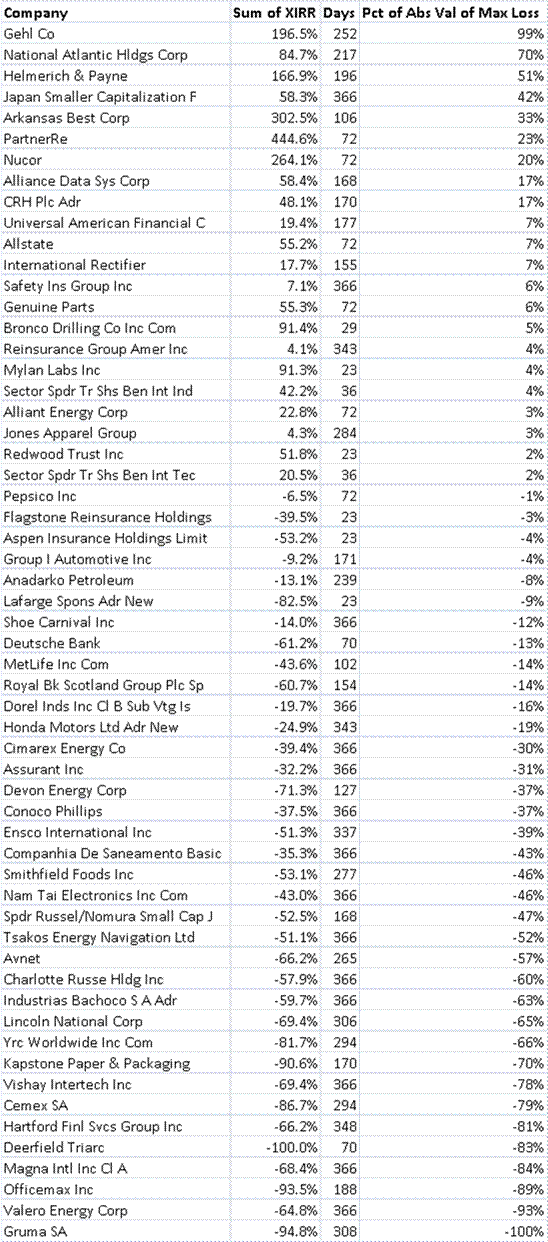
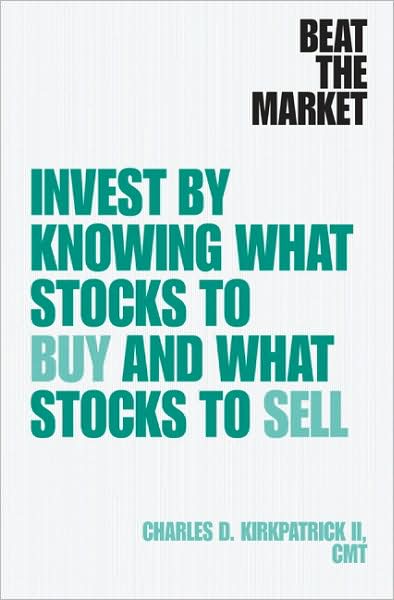 I am usually not crazy about books that propound a simple way to beat the market.? This is one of those books.? What makes me willing to write a review about this book, is that the writer, Charles Kirkpatrick is willing to incorporate some fundamental measures into his analyses, notably price-to-sales, which will help with industrial companies, but not with financials.
I am usually not crazy about books that propound a simple way to beat the market.? This is one of those books.? What makes me willing to write a review about this book, is that the writer, Charles Kirkpatrick is willing to incorporate some fundamental measures into his analyses, notably price-to-sales, which will help with industrial companies, but not with financials.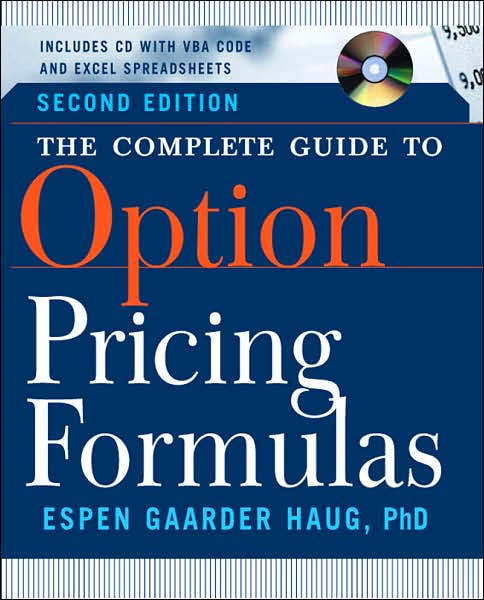 This is not my ordinary book review.? These are good books that will only appeal to a small fraction of my readers, because few will have need for the knowledge. Both are written by Espen Gaarder Haug, who is kind of a character.? He collects option pricing formulas the way some people collect Barbie Dolls, Beanie Babies, or Baseball Cards.? He has interacted with some of the brightest minds in the field, and collaborated with a few of them.? In both books the math is significant — it would help if your calculus was sharp, and for any value some algebraic knowledge is needed.
This is not my ordinary book review.? These are good books that will only appeal to a small fraction of my readers, because few will have need for the knowledge. Both are written by Espen Gaarder Haug, who is kind of a character.? He collects option pricing formulas the way some people collect Barbie Dolls, Beanie Babies, or Baseball Cards.? He has interacted with some of the brightest minds in the field, and collaborated with a few of them.? In both books the math is significant — it would help if your calculus was sharp, and for any value some algebraic knowledge is needed. The second book Derivatives, Models on Models, is different.? He interviews 15 significant thinkers on options and derivatives, and presents 15 papers by them.? Most of them contain tough math; some I couldn’t understand.? The real value of the book was in the interviews, where many of the interviewees showed significant knowledge of the limitations of their models, and how derivatives were misunderstood by the public, or by their users.
The second book Derivatives, Models on Models, is different.? He interviews 15 significant thinkers on options and derivatives, and presents 15 papers by them.? Most of them contain tough math; some I couldn’t understand.? The real value of the book was in the interviews, where many of the interviewees showed significant knowledge of the limitations of their models, and how derivatives were misunderstood by the public, or by their users.